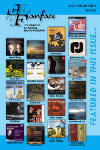Texte paru dans: / Appeared in: |
|
| Appréciation d'ensemble / Overall evaluation : "Very strongly recommended". | |
|
Reviewer:
Jerry Dubins This is the third volume to be released in Sergio Azzolini and L’Aura Soave Cremona’s slowly unfolding survey of Vivaldi’s bassoon concertos. Volume 1, which contained only three of the composer’s concertos for a solo bassoon, plus two for oboe, and a double concerto for bassoon and oboe, was reviewed as far back as issue 28: 5 (May/June, 2005) by Brian Robins. It wasn’t until seven years later, in issue 35:5 (May/June, 2012) that Volume 2 was reviewed by Bertil van Boer. That second volume was devoted exclusively to the bassoon concertos, offering another seven of them. With the arrival of this latest installment a little over a year later, Azzolini appears to have picked up the pace. The current volume, also given over wholly to Vivaldi’s concertos for bassoon, adds another six to the previous releases for a total of 16, if one counts just the concertos featuring a solo bassoon. Given that Vivaldi wrote 37 concertos for the instrument—39, if you include two that are incomplete (RV 468 and 482), Azzolini hasn’t even reached the halfway point. L’Aura Soave Cremona is a period-instrument ensemble, which, in numbers—six violins, two violas, two cellos, double bass, archlute alternating with baroque guitar, and harpsichord alternating with organ—thankfully eschews the paradoxical, if not perverse, notion of performing concertos with a ripieno comprised of one instrument to a part. Should one happen to wonder why Vivaldi wrote so many concertos for an instrument as seemingly unwieldy as the bassoon and still not fully evolved—the models of his day had only four keys, possibly five, spanning a range of two octaves below middle C to the G above middle C—it would be easy to speculate that the composer had to come up with something to keep his bassoon-playing girls at the orphanage busy. But the easy answer, in this case, would probably not be the right one. Most scholars seem to agree that Vivaldi’s bassoon concertos postdate the period during which he was fully engaged in teaching and composing at the Ospedale della Pietà from 1703 to around 1718, with several leaves of absence in between to accommodate his opera producing activities. Evidence for later composition of the bassoon concertos comes in the form of (1) a couple of dedications to individuals not associated with the Ospedale, one of them dated 1727; and (2) the technical challenges posed by the writing, which suggest that the concertos were intended for professional, virtuoso performers, such as Anton Möser, who, it’s believed, may have played some of these works at the court of Count Wenzel von Morzin as late as 1737. What’s clear is that Vivaldi exploits the full capabilities of the instrument of the time, demanding of the player lickety-split lipping and fingering, leaping from the lowest to the highest notes, and sustained breath control over long-arching phrases. Once upon a time, I had in my collection Daniel Smith’s five-disc set of the concertos spread among the English Chamber Orchestra and the Zagreb Soloists. Perhaps it was just me, but I thought that Smith had intonation problems, which I found annoying enough to warrant disposal of the discs. In any case, for performances on modern instruments, which Smith’s were, I much preferred the CDs that Philips came out with featuring Klaus Thunemann and I Musici, but I’m not sure if Thunemann ever proceeded beyond the two discs I have containing 12 of the concertos. You can still purchase the two CDs separately for $16.99 each at Amazon, or you can buy them in what is supposed to be Philips’s twofer budget series from the same source for $58! For a long time, Smith was (and, as of now, still is) your only choice for all 37 of the bassoon concertos. But Tamas Benkocs with Béla Drahos leading the Nicolaus Esterházy Orchestra on Naxos is on track to end Smith’s exclusive rein. With five discs and 31 concertos already released, Benkocs should complete his survey with just one more album. As far as I know, Sergio Azzolini and L’Aura Soave Cremona have no competition for a complete cycle of the bassoon concertos on period instruments. At the pace of their progress, however, I, for one, may not live to see it completed. But based on this current volume, I can tell you that I’ve never heard a bassoonist more nimble when it comes to negotiating Vivaldi’s rapid passagework or more evenly and liquid-toned in the music’s inimitable, slow-movement Italian cantilenas. L’Aura Soave Cremona, under the direction of Diego Cantalupi, is perfectly sized for these concertos and perfect in every other respect. Very strongly recommended. | |
|
|
|
|
|
|
|
Cliquez l'un ou l'autre
bouton pour découvrir bien d'autres critiques de CD |
|




